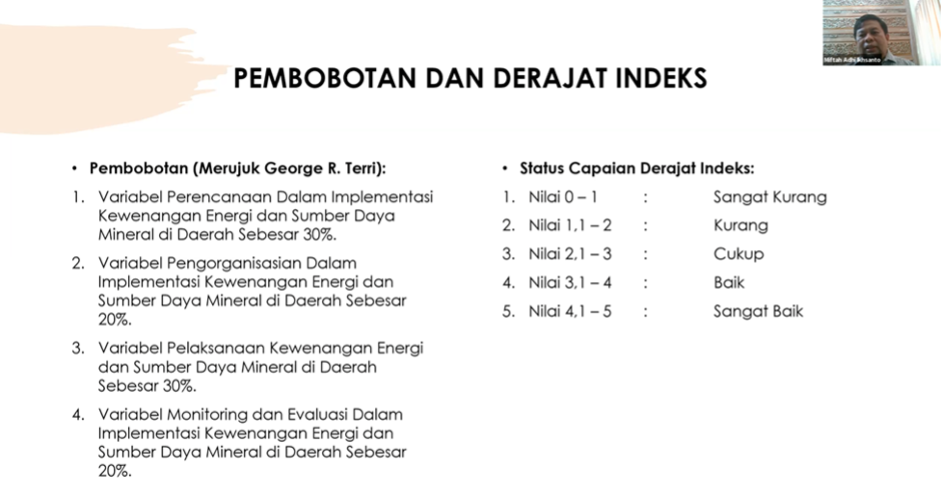Jakarta – The enactment of Law Number 23 of 2014 concerning Regional Government has implications for shifting the authority to administer government affairs in the Energy and Mineral Resources (ESDM) sector. The implication of the shift in authority is that district/city governments are no longer given the authority to regulate all matters relating to extractive industries such as forestry, marine, and Energy and Mineral Resources.
Based on these conditions, PWYP Indonesia, in collaboration with the Directorate General of Regional Development (Ditjen Bina Bangda), the Ministry of Home Affairs (Kemendagri), initiated the preparation of performance measurement instruments for the administration of government affairs in the Energy and Mineral Resources sector in the regions. Through a focused discussion held on Friday (18/2) online, it was revealed that this effort aims to produce performance measurement tools in the aspects of planning, organizing, implementing, monitoring, and evaluating the management of Energy and Mineral Resources authority in the regions.
Miftah Adhi Ikhsanto, the expert who compiled the performance measurement instrument, explained that the preparation of this instrument was based on several legal grounds. Namely, Law no. 23 of 2014 concerning Regional Government; PP No. 18 of 2016 concerning Regional Apparatus; PP No. 12 of 2017 concerning the Guidance and Supervision of Regional Government Administration; and Permendagri No. 13 of 2021 concerning the Organization and Work Procedures of the Ministry of Home Affairs. In its implementation to this day, it is still found that there are obstacles at the operational level of the management of the Energy and Mineral Resources authority originating from the process of institutionalizing affairs at the local level and their integration with national priority programs.
“Thus, this measurement instrument was prepared to see how the integration of Energy and Mineral Resources affairs in the regions through its autonomy with the implementation of national program priorities in the Energy and Mineral Resources sector,” said Miftah.
At the operational level, the management of the Energy and Mineral Resources Authority has several obstacles stemming from institutionalizing authority at the regional level. In this case, the authority in Energy and Mineral Resources is the authority of choice. It means that not all regions can institutionalize this authority if they do not have potential in geology, minerals and coal, Renewable Energy (ET), and the electricity sector. As a result, the achievement targets in the Energy and Mineral Resources sector nationally have not been optimally integrated into regional development targets.
For this reason, Miftah also explained that this instrument is also expected to produce outputs in the form of a performance index of implementation, planning, organization and management, implementation, monitoring, and evaluation in the implementation of government affairs in the field of Energy and Mineral Resources in the regions. “In this case, each index has its weight,” Miftah explained.
The performance measurement principles are built on several principles, namely transparent, concrete, consistent, objective, and accountable. “Transparent means that it must be easily accessible, while concrete means accurate and precise. Consistent means it is necessary to pay attention to data availability, information, and other completeness needed in the assessment. At the same time, objective means that it is carried out professionally, and accountable means that it must be accounted for its accuracy. Miftah explained.
Dodo Hia, from the Directorate General of Regional Autonomy, Ministry of Home Affairs, appreciated the collaboration in preparing the instrument by looking at the variables and indicators of good assessment. Dodo hopes this process does not overlap with the authorities between agencies but instead is directed towards synergy.
On the other hand, Agus Nurhudoyo, from the Secretariat General of the Ministry of Energy and Mineral Resources, described the conditions and unique challenges found in regions where the average performance of local governments related to their main tasks and functions is only limited to the electrification ratio and Renewable Energy.
“It is the electrification and Renewable Energy ratio must be increased due to an increase in the energy mix. For example, if the area of income increases, then consumption increases. This increase is seen; if the electricity consumption increases, the economy will increase.” said Agus.
Meanwhile, Aryanto Nugroho, the Coordinator of PWYP Indonesia, hopes that in the future, this instrument can be developed not only for the Energy and Mineral Resource sector but also for other sectors. Meanwhile, Tavip Rubiyanto from the Directorate General of Regional Development, Ministry of Home Affairs, saw the need for a follow-up meeting to finalize the measurement instrument that was being worked on based on the input received.
Author: S. Al Ayubi
Reviewer: Meliana Lumbantoruan
